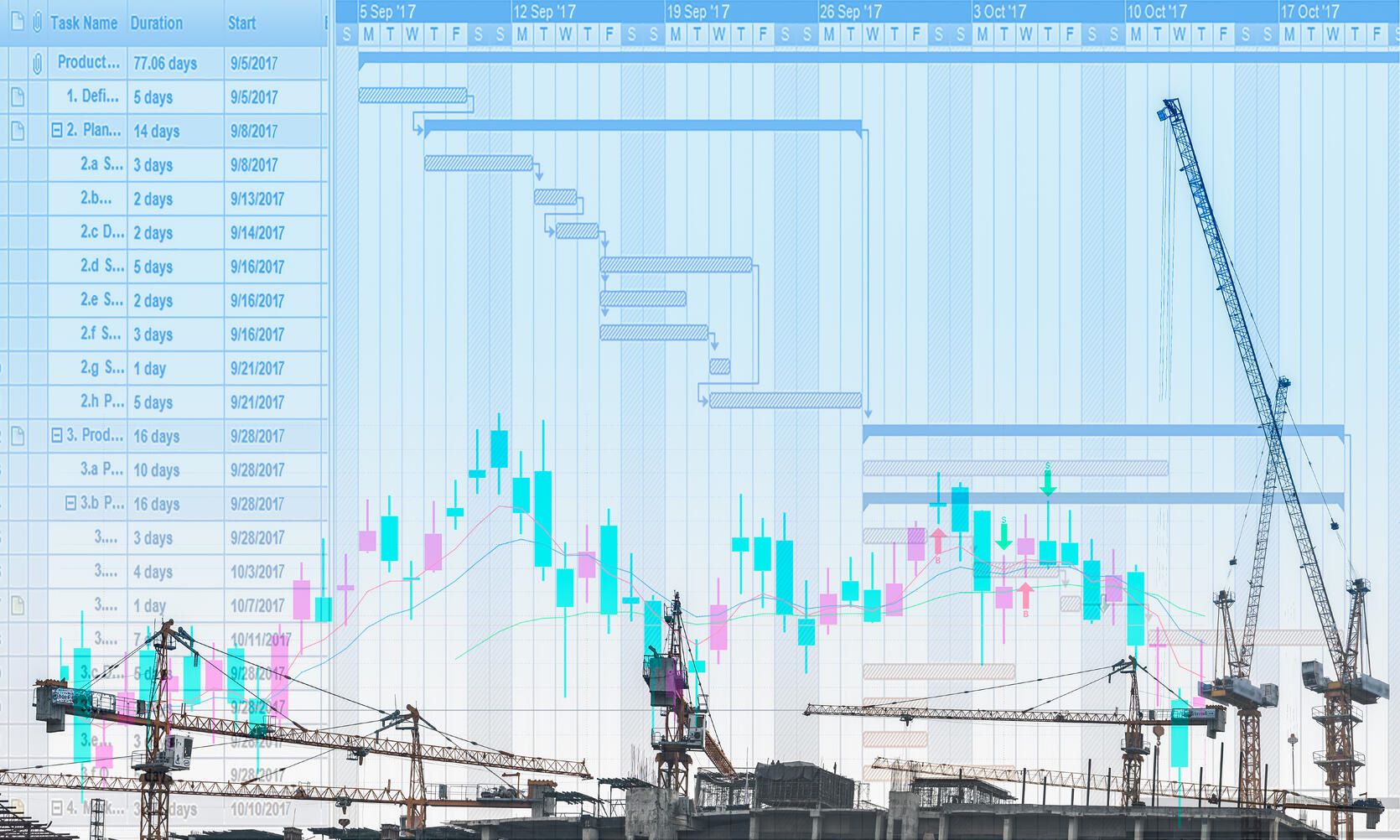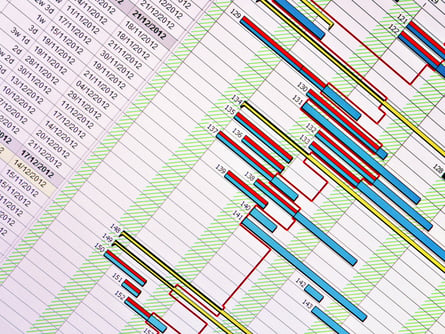Visual Scheduling (4D BIM)
Visualize your design and construction phasing solutions in line with the start and end date for your building project timeline.
Improve coordination among stakeholders and eliminate risks associated with schedule-related tasks such as construction site logistics.
Utilize state-of-the-art building information modeling tool to instigate innovation on your project team and workflows.

If you think that BIM stops at three-dimensional spatial realm, you're wrong. Enter 4D BIM, where four-dimensional refers to the added layer of time on top of smart 3D building information models.
Most AEC industry specialists who are satisifed with three-dimensional modeling process do not see the significance of 4D BIM yet, but at Nearby EngineersNew York Engineers, we see the opposite. Whether your building facility requires fast-track construction or not, integrated project scheduling redefines visualization on a whole another level. This helps us to see how parallel workflows can be an asset for your building project, rather than going through the inefficient linear build model.
Small-scale firms who have only taken the jump as of late are currently going through the learning curve in the wide adoption of BIM. However, BIM is fast developing, and to rise to the top means you have to learn how disruption works and ride the revolution. Otherwise, lack of continuing professional development on your end will lead to competitors outperforming your firm and losing on bidding projects.
For forward-thinkers like our engineers, conforming to old workflows equates to stagnancy. Through a seamless blend of curiosity, expertise and innovation, we weave through the intricacies of modern workflows and translate this to simple solutions in the form of smart 4D visual scheduling on your BIM-ready building construction projects. At Nearby EngineersNew York Engineers, we use our foresight to visualize your success.

Visual scheduling continuously blazes trail in the AEC landscape with technological innovation in building information modeling. As such, linear 2D workflows are still visibly present for drafting precision lineworks, but now desired on to a lesser extent as they lack the flexibility in managing the demands of your complex building projects.
Add another dimension in 3D models, and enter into the realm of time with 4D BIM. Our engineers show you the game-changing benefits you can yield when you utilize 4D BIM for your next project:
As you can see, visual scheduling not only accounts for its time functionality, but more so on the overall aspects of your building project. At Nearby EngineersNew York Engineers, we aim for a unique holistic approach so you can garner holistic benefits on your project drivers.
In a large-scale construction project, complexity becomes the norm especially when different core elements are factored in. This can range from materials to equipment, and labor workforce manning your construction site to completion. At the onset of contractor bidding process, your build model can either be structured by multi-prime or general contracting. Whichever project delivery method you choose, one thing is certain: build sequence is one challenging task to undertake not only on the client's end, but more so on the side of professionals orchestrating the whole construction sequence.
Where general contracting (GC) mandates a single point-of-responsibility, multi-prime on the other hand works by different construction trades. If communication is the key criteria in the make-or-break of your construction project, then the former option wins over the latter as per the client's perspective. Subcontractors work under the premise of the GC, which consequently serves as the single point-of-contact for the owner. Multi-prime leans on the opposite spectrum with specialized contractors working on their forte of construction trades.
In turn, this makes coordination much more complex in multi-prime contracting, but is one that poses greater control point on the client's technical and financial aspects due to quality control and value-engineering. It is only rightly fitting that these complex project drivers can be neutralized through visual scheduling. At Nearby EngineersNew York Engineers, we utilize 4D BIM to equalize all your project constraints.
Construction build sequence on its own requires AEC industry experts to be in sync during interfacing of the trades. Anytime at all that responsibility matrix is not practiced, this poses safety hazards on your construction workforce. Take fast-track construction of high-rise office projects, for example.
Our experienced MEP engineers show you the typical build sequence for MEP engineering in line with multi-prime contracting:
Parallel workflows enable you to work on the critical path item, giving you the lead time to enter the construction phase via 4D BIM visual scheduling and handover date from the package contractors. At Nearby EngineersNew York Engineers, we give you the power to calculate the discrepancies between planned versus actual dates so you can assess early or late building project handover.

As our industry counterparts, project and construction managers usually ensure that your building project is delivered with quality, on time and within your specified budget.
This is by no means an easy feat, as prerequisites for excellent project delivery include:
When you use 4D BIM for your project, you combine all these criteria items for your all-in-one benefit. Conventional workflows typically include disjointed construction documents and project schedules, but 4D BIM eliminates all these disconnects with integrated Gantt charts and critical path methods on your intelligent 3D-based BIM models.
4D BIM acts as your accessible visual reference—enabling you to stack up all your construction program data against your project timeline so you can see which tasks for short on their deadline, which float items demand lax supervision on earliest and latest start dates, or which ones hit your non-negligible critical path item for real impact.
Our proactive engineers keep you up-to-date and in-the-loop for critical path items which might advance or negate the successful delivery of your project. Using our engineering expertise, we keep constructability in check with project schedules to execute your building visions to life.
Building your project ideas to life are not without hard and smart work, as attested by AEC industry professionals ranging from architects, engineers, project managers, construction managers, contractors, fabricators, facilities managers, vendors and suppliers. If you are a first-time client or an experienced building owner undergoing new construction or renovation, know that there's a trifecta at work in delivering a successful building construction project.
Below are the three critical project constraints which make up the Project Management Triangle:
Any component you move on the slider effectively moves the other two constraints. Our engineers clue you in on these three principles we keep in application: fast and good is not cheap, cheap and good is not fast, and lastly, fast and cheap is not good. On a side note, however, our engineers negate the first item as you can also achieve fast and quality results with lesser costs through our value-engineering services.
For your better understanding, let's apply this in light of how project constraints occur in building and construction sector. In an agile construction where all elements are geared up for accelerated workflow, any such time that the contractor doesn't meet your specified handover dates for the construction phasing usually translates to higher purchase orders, rushed timelines and compromised quality and safety. Oppositely, if the contractor is not in question and the client implements unnecessary hold orders due to negative cash flow, this can possibly lead to delayed timelines and even worse, liquidated damages on the contractor's end.
All these undesirable scenarios lead us to develop a two-way solution which will cater to both technical and legal perspectives. At Nearby EngineersNew York Engineers, we utilize 4D BIM and visual scheduling to pull the cost and quality constraints out of the extremes—effectively reducing liabilities on all aspects. Our aim is to make visual scheduling a priority in your project, so you do not have to go to such extent where mediation and arbitrary disputes happen between parties, as this could be very costly for your business' bottomline despite legal contracts designed to protect every stakeholder.
Visual scheduling plays a key role in understanding how site logistics and safety planning work. Constructing a building facility is a very critical point for all AEC industry players, and with this multi-collaborative notion comes complexity in juggling all ingredients for your recipe to success.
Here at Nearby EngineersNew York Engineers, we lay out all the stage-by-stage items you need to consider in the construction site logistics and safety planning of your building project:
At best, it's easier to coordinate supply chain management and construction site logistics with visual scheduling in place. Through 4D BIM, our innovative engineers know just when the right timing is for each stage implementation. We facilitate our expertise with visual technology and economic demand and supply so that we'll know when to source, purchase, deliver, store and assemble materials for your building facility.
BIM only used to be a buzzword, but as of late it's becoming a household name in the AEC industry especially since small-scale to large-scale firms are now realizing the multi-layered benefits of BIM for all industry players and project stakeholders.
From clientele to project teams and future end-users, BIM is a disruptor in the technological aspect of architecture, engineering and construction landscape. What was once a blanket of 2D workflows are now replaced with inventive 3D models. Even much better, 4D BIM adds an immersive time-sensitive dimension for your real-time visualizations and change management on cost, quality and financial aspects. This means that the efficiency of your building construction is at its finest from start to the end, since visual schedules are transparent from design, to construction and operational stage.
At Nearby EngineersNew York Engineers, efficient innovation is our middle name.
Understand how project timeline functions along with cost and quality drivers so that it can work for you, and not against you. At Nearby EngineersNew York Engineers, we merge the functionalities of project constraints on an efficient visual scheduling so that you can achieve an early handover date, maximum returns on investment, and cutting-edge quality on your building facilities.
Our leading-edge engineers value visual scheduling for its core emblems of direct communication, efficiency, collaboration and potential for innovation. Learn more of how our engineers defy the limit of time with visual scheduling or 4D BIM in our list of sector-specific projects.